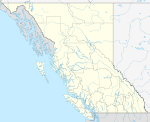Sunshine Coast Regional District
Sunshine Coast | |
|---|---|
| Sunshine Coast Regional District | |
 Sechelt Inlet | |
 Location in British Columbia | |
| Country | Canada |
| Province | British Columbia |
| Administrative office location | Sechelt |
| Government | |
| • Type | Regional district |
| • Body | Board of Directors |
| • Chair | Lori Pratt (B) |
| • Vice Chair | Alton Toth (Sechelt) |
| • Electoral Areas |
|
| Area | |
| • Land | 3,773.73 km2 (1,457.05 sq mi) |
| Population (2016)[2] | |
| • Total | 29,970 |
| • Density | 7.94/km2 (20.6/sq mi) |
| Website | scrd.ca |
The Sunshine Coast Regional District is a regional district in British Columbia, Canada. It is located on the southern mainland coast, across Georgia Strait (part of the Salish Sea) from Vancouver Island. It borders on the qathet Regional District to the north, the Squamish-Lillooet Regional District to the east, and, across Howe Sound, the Metro Vancouver District to the south. The regional district offices are located in the District Municipality of Sechelt.
Geography[]
The majority of the Sunshine Coast is sparsely populated. The Coast Mountains make up the inland area. Population is concentrated along the coast. Midway up the coast, beginning at the town of Sechelt, the coastal area forms a peninsula separated from the inland area by Sechelt Inlet. The 2016 census reported a total population of 29,970 persons[3] living on a land area of 3,778.17 km2 (1,458.76 sq mi).
The Sunshine Coast is typically accessed via boat or plane; no roads connect the district with the rest of the province. From Vancouver, ferries run from Horseshoe Bay to Gibsons across Howe Sound. At the northern end of the peninsula, ferries run from Earl's Cove to Saltery Bay.
Communities[]
District municipality[]
- Sechelt - Pop 10,200
Town[]
- Gibsons - Pop 4,605
Indian government district[]
- Sechelt (Part) - Pop 819
Indian reserves[]
- Chekwelp 26
- Chekwelp 26A
- 27
Unincorporated[]
- Roberts Creek - Pop 3,421
- Halfmoon Bay
- Madeira Park
- Garden Bay
Electoral areas[]
- Pender Harbour/Egmont/Madeira Park () - Pop 2,678 [4]
- Halfmoon Bay (Electoral Area B) - Pop 2,675 [5]
- Roberts Creek (Electoral Area D) - Pop 3,244 [6]
- Elphinstone () - Pop 3,482 [7]
- West Howe Sound (Electoral Area F) - Pop 2,043 [8]
(all population figures from 2011 Census)
Demographics[]
(Statistics Canada, 2016)[9]
- Population: 29,970
- Population change (2011-2016): 4.7%
- Resident inhabited dwellings: 13,995
- Land area (km2.): 3,773.73
Provincial Parks[]
See also[]
References[]
- Sources
- Notes
- ^ "Board of Directors". Retrieved July 9, 2019.
- ^ a b "Population and dwelling counts, for Canada, provinces and territories, and census divisions, 2016 and 2011 censuses – 100% data (British Columbia)". Statistics Canada. February 8, 2017. Retrieved July 9, 2019.
- ^ [1]. 12.statcan.gc.ca. Retrieved on 2020-11-07.
- ^ Census Profile. 2.statcan.gc.ca. Retrieved on 2014-04-12.
- ^ Census Profile. 2.statcan.gc.ca. Retrieved on 2014-04-12.
- ^ Census Profile. 2.statcan.gc.ca. Retrieved on 2014-04-12.
- ^ Census Profile. 2.statcan.gc.ca. Retrieved on 2014-04-12.
- ^ http://www12.statcan.ca/census-recensement/2016/dp-pd/prof/details/page.cfm?Lang=E&Geo1=CSD&Code1=5929028&Geo2=CD&Code2=5929&Data=Count&SearchText=V0N1V6&SearchType=Begins&SearchPR=01&B1=All&TABID=2
- ^ Census Profile. 2.statcan.gc.ca. Retrieved on 2021-07-09.
External links[]
| Wikimedia Commons has media related to Sunshine Coast Regional District. |
- Sunshine Coast Regional District
- Regional districts of British Columbia
